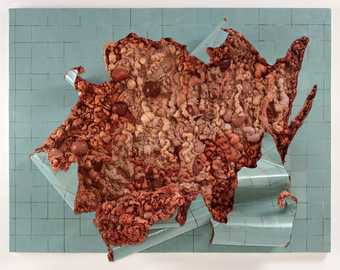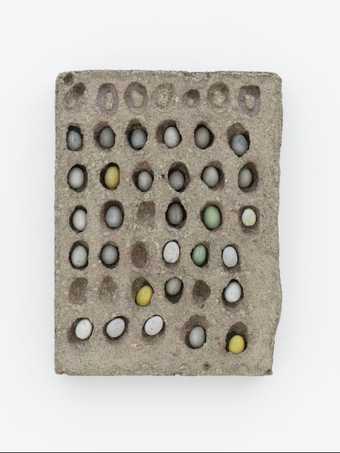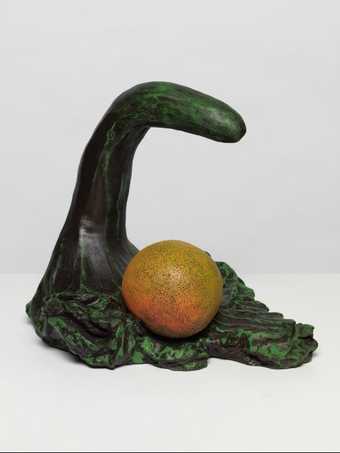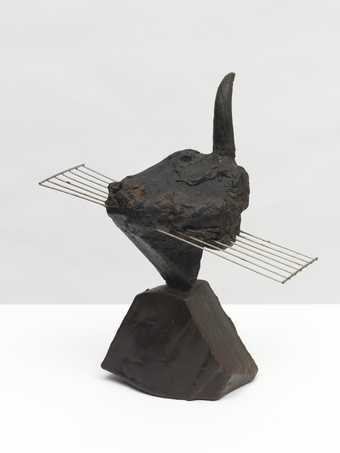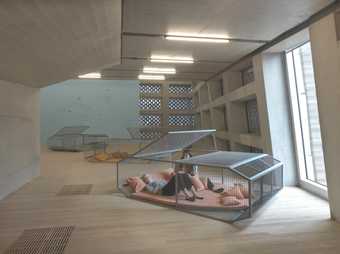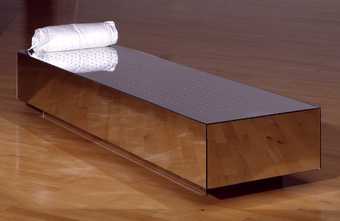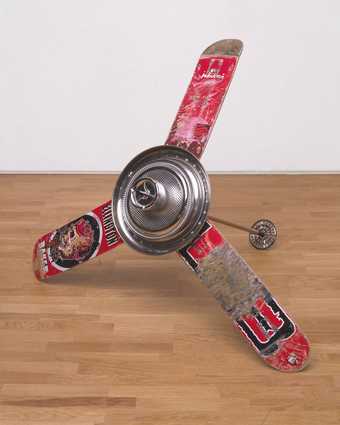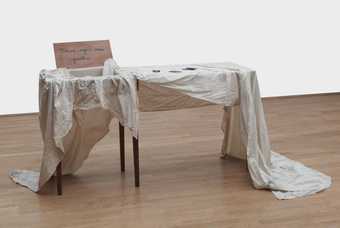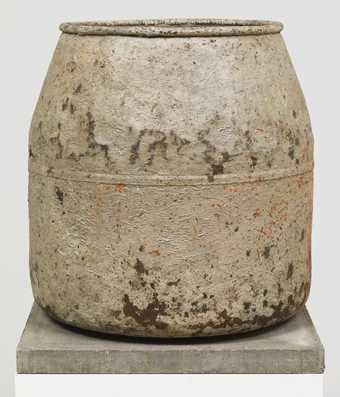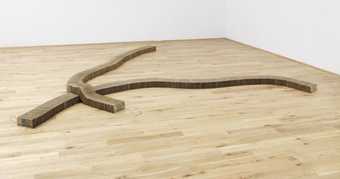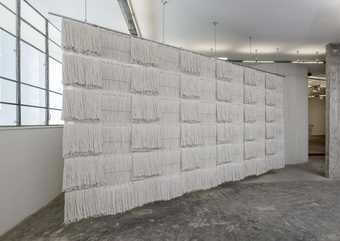
In Tate Liverpool
- Artist
- Alexandre da Cunha born 1969
- Medium
- 3 skateboards, steel and chrome
- Dimensions
- Object: 1035 × 1350 × 1045 mm
- Collection
- Tate
- Acquisition
- Purchased using funds provided by the 2005 Outset / Frieze Art Fair Fund to benefit the Tate Collection 2006
- Reference
- T12173
Summary
Skateboarderistismatronics (fan) 2004 is a floor-based sculpture by the British-Brazilian artist Alexandre da Cunha that comprises three skateboards with their wheels removed arranged in a three-armed configuration to resemble a domestic ceiling fan. At the centre of the work, four lightweight metal objects – a cake mould, a salad bowl, a circular baking tray and a film canister lid – are threaded onto a plastic-covered metal broom handle using a series of wing nuts and bolts. The work is balanced on the floor, with two of the skateboards touching the ground and a third support provided by the lower end of the broom handle, onto which is attached another, smaller metal ring mould.
This work is part of a group of sculptures entitled Fan Series that the artist produced between 2004 and 2005 (see, for example, Erik Ellington (fan) 2004, Tate T12174, and Bored Onboard (fan) 2005, Ellipse Foundation Collection, Lisbon). The cheap domestic cooking items and other low-cost metal objects employed by da Cunha in these works were either found in streets or homes or were purchased by the artist at markets and discount shops close to his London and São Paulo studios. Typical of the kinds of cooking utensils and other objects used in working class Brazilian households, the artist made no attempt to alter these items’ low-cost appearance or disguise their original function when assembling them into his fan-shaped formations. In 2006 da Cunha commented on the fact that unlike more traditional sculptural materials such as bronze or marble, the components he uses to make his works have no inherent economic value, and he described the objects he employs as ‘things I found on the streets, in the front of houses, in box rooms, pantries, ready for the garbage can’ (quoted in Rodrigo Moura, ‘Economies of Desire’, in Paço das Artes 2006, p.10). Similarly, the recycled skateboards used by the artist possess no significant monetary worth, yet despite this, as da Cunha outlined in 2006, the boards are often of huge personal value to the skaters, with their scratches, dents, stickers and texts providing visual documentation of each skater’s private history, failures and achievements (see Alexandre da Cunha, email to Emily Fryer, Sculpture Conservator, Tate, 11 February 2006, Tate Conservation file).
Discussing da Cunha’s practice of reusing inexpensive materials in order to highlight their unnoticed aesthetic properties, curator Michael Darling has described the artist as ‘a poet of found materials. Rarely making objects from scratch, da Cunha instead finds wondrously creative ways to repurpose already-existing items, revealing their inherent if overlooked form, beauty, and mystery’ (Michael Darling, ‘MCA Chicago Plaza Project: Alexandre da Cunha’, exhibition guide, Museum of Contemporary Art Chicago, Chicago 2015, http://www2.mcachicago.org/exhibition/mca-chicago-plaza-project-alexandre-da-cunha/, accessed 22 July 2015). The insubstantial costs associated with the materials da Cunha uses to construct his sculptures stand in stark contrast to the high economic value that the art market places on objects when they enter into the established system of museums, art fairs and galleries. Curator Rodrigo Moura has described da Cunha’s attempt to highlight the extreme variation that exists in the perceived value of the materials he uses in the different contexts in which they appear – a working-class Brazilian kitchen, an art museum, a skate park – as an act of ‘smuggling, seduction and subversion’ (Moura 2006, p.10).
The word ‘Skateboarderistismatronics’ in the title is taken from an inscription written clearly in white lettering on one of the skateboards. Da Cunha has employed the same titling system for all of the works in the Fan Series: for example, Erik Ellington (fan) features the name of this famous skater plainly printed on one of its skateboards. The conspicuous transparency of the artist’s method of titling his sculptures, along with his refusal to amend the objects he employs, act as a way of further acknowledging the artwork’s immediate debt to the street culture from which it emerges. As the artist Kader Attia has observed of this particular work, ‘What’s important in Skateboarderistismatronics (fan) 2004 is that da Cunha transforms manufactured objects by re-contextualising them, but he does not alter their form’ (Attia 2011, accessed 6 July 2015). Attia goes on to highlight the way in which da Cunha’s Fan Series questions the aesthetic relationship between Western and non-Western worlds, stating that ‘I like to imagine that one would find a ceiling fan like da Cunha’s in South American modernist buildings like the houses created by the Brazilian architect Lino Bo Bardi’ (Attia 2011, accessed 6 July 2015).
Further reading
Alexandre da Cunha, exhibition catalogue, Paço das Artes, São Paulo 2006, pp.9–14, reproduced pp.32–3.
Kader Attia, Artists’ Perspectives: Aesthetic Anthropophagy, Tate blog, 6 October 2011, http://www.tate.org.uk/context-comment/blogs/artists-perspectives-aesthetic-anthropophagy-kader-attia, accessed 6 July 2015, reproduced.
Judith Wilkinson
July 2015
Supported by Christie’s.
Does this text contain inaccurate information or language that you feel we should improve or change? We would like to hear from you.
Explore
- emotions, concepts and ideas(16,416)
-
- formal qualities(12,454)
- electrical appliances(404)
-
- fan(8)
- skate board(2)
You might like
-
Adriana Varejao Green Tilework in Live Flesh
2000 -
Erika Verzutti Pencil
2014 -
Erika Verzutti Brazil
2018 -
Erika Verzutti Tarsila with Orange
2011 -
Donald Locke The Remains of Captain Bull #1
2001 -
Ricardo Basbaum Capsules (NBP x me-you)
2000 -
Valeska Soares Fainting Couch (Prototype)
2002 -
Alexandre da Cunha Erik Ellington (fan)
2004 -
Marepe Deposit your lice here
1999 -
Cildo Meireles Babel
2001 -
Alexandre da Cunha Full Catastrophe (Drum VIII)
2012 -
Tonico Lemos Auad Procissão 1
2013 -
Rivane Neuenschwander Commonplace
1999 -
Jac Leirner Blue Phase
1991 -
Alexandre da Cunha Kentucky (Biombo)
2017

